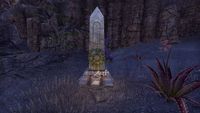The Old Life Festival, sometimes simply called Old Life, is primarily an Imperial holiday[1] but it is also celebrated throughout Tamriel by other cultures in their own unique ways due to the reach and influence of the Empire.[2][3]:16 It falls at the last day of the year, and is a time people write messages of remembrance for their dead loved ones, and may occasionally receive an answer from Aetherius.[1] Old Life pilgrimage shrines can be found throughout Tamriel, from the west in Summerset's Auridon, all the way to the east in Morrowind's Stonefalls.[4] People who are unable to travel to the pilgrimage sites can have a proxy deliver their messages, and if they receive a response, they will know.[1]
During the Third Era in the Septim Empire, the holiday was celebrated by going to the temple to reflect on their past. Some would go for more than this, for it is rumored that priests will as the last act of the year perform resurrections on beloved friends and family members free of the usual charge. Worshippers know better than to expect this philanthropy, but they arrive in a macabre procession with the recently deceased nevertheless.[2]
The Old Life Festival complements the New Life Festival, and both are considered two sides of the same coin. By acknowledging those that have passed, one can begin to move forward, as the pilgrimage shrines serve as a vessel for letting the departed know the things people held to themselves while they were alive. Those who receive a response from a spirit may feel it is a life-changing experience.[1]
TraditionsEdit
Witches celebrate Old Life with dark festivities, and to cast aside the old to bring in the new year, the living bring them the husks of those that died. To summon the sun, the dead are reanimated to dance a jig along with the living.[5]
Dark tales and unsettling songs are told as part of the Old Life traditions to commemorate the shortening of the days with Old Life. Tales like The Unknown Passenger involving an unknown hitchhiker, The Lost Fawn in the Woods, where the fawn learns of a wolf wearing its mother's skin and in its panick, flees into the wolf's den, and The Midnight Lodger, where the renter vanishes with the innkeeper's child before morning. One of these stories, The Wolf That Craved the Sky, involves Storihbeg,[5] Hircine's Skinchanger aspect.[6] The Reachmen version states that with the coming of the New Life Festival, two of Hircine's aspects come to conflict with each other. New Life marks the winter solstice, when the days begin to lengthen due to the return of the sun. Storihbeg the Man-Beast thus pursues the sun in an attempt to eat it, an effort to keep the nights longer. To prevent this, Reachmen summon Hrokkibeg the Mighty Bear to challenge Storihbeg.[5]
In the Nordic version of the tale, the Skinchanger has an endless hunger which once drove it to feast on the volcanoes of Morrowind and drink the Iliac Bay dry, thus creating the Alik'r Desert, before using Valenwood's trees for its oral hygiene. Seeing the moons untroubled, Storihbeg threatened to consume them. The agile Wolf claimed he could jump from the highest mountain to reach the moons, to which the moons responded that everyone would know they went missing. The Skinchanger said he could assume their forms, his eyes replicating their moonlight. But the moons then pointed out that the sun would know that the moons were no longer what they appeared. Storihbeg merely replied that he would eat the sun too, as well as all the stars. After his feast, the world would be filled with nothing but darkness, and he would then engulf the world and let out a howl. Yet the moons mocked the Wolf, stating that the sun's light is too rich of a meal. And so to prove them wrong, the Skinchanger waited for the sun to be at its weakest (when the Old Life Festival is celebrated), but the sun had other plans: it flared and burned bright (coinciding with the New Life Festival) and stopped the devourer in its tracks, sending it yelping away in pain.[6]
The Rite of Akatosh is an endeavor performed by Cyrodilic elders in preparation for the New Life Festival, in which their party goes on a pilgrimage to rid the nearby forests of "Old Life": monsters such as Goblins, Ogres, and trolls. The party then challenges an Avatar of Akatosh, which manifests as a fearsome golden Dragon. By successfully defeating this avatar, the elders believe that the God of Time will grant them more time, youth, or peace. Some also hope that that the feat will grant them respect.[7]
GalleryEdit
NotesEdit
- Daggerfall had the last day of the year and therefore the day the Old Life Festival fell on in its calender as the 30th of Evening Star.[2] However, future Elder Scrolls games has the last day of the year as the 31st of Evening Star.[8]
See AlsoEdit
- For game-specific information, see the Daggerfall and Elder Scrolls Online articles.
BooksEdit
- From Old Life To New by Botjolf Meadwarmer — The tale of a mythical hungry wolf
ReferencesEdit
- ^ a b c d Petronius Galenus' dialogue in ESO
- ^ a b c Old Life Festival description in Daggerfall
- ^ The Elder Scrolls: The Official Cookbook — Chelsea Monroe-Cassel
- ^ Events of Old Life Observance in ESO
- ^ a b c New Life Festival Interview — Countess Aurorelle Edrald, Marwig Yeomcroft, Priestess Phaziyya, and Mochtuinne Eye-Tooth
- ^ a b From Old Life To New — Botjolf Meadwarmer
- ^ The Rite of Akatosh event and related Rulings in Castles
- ^ Calendar in Skyrim
